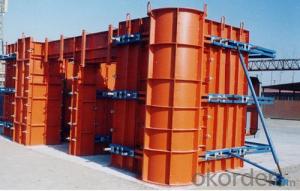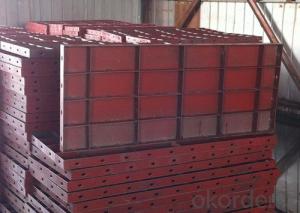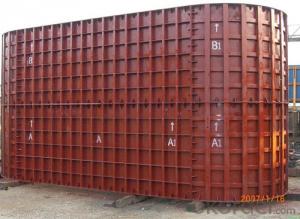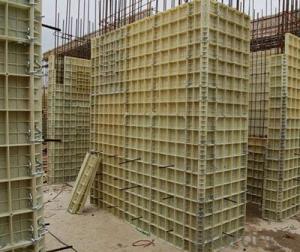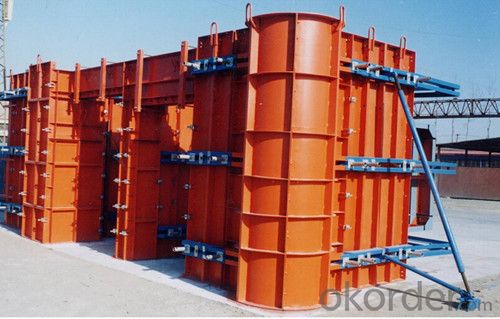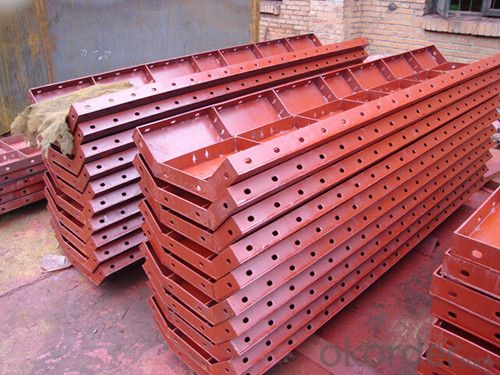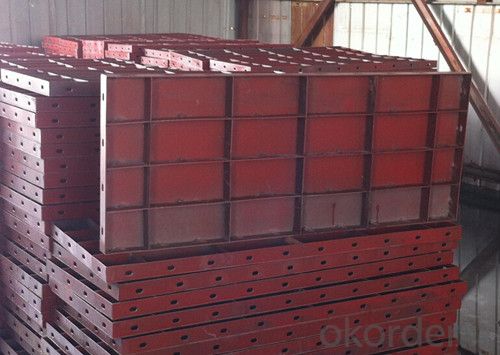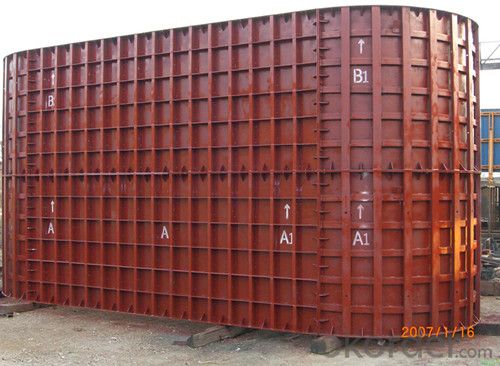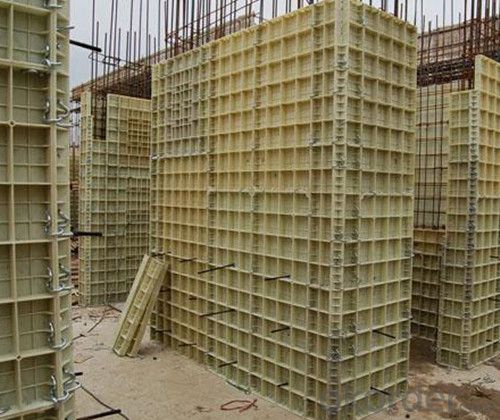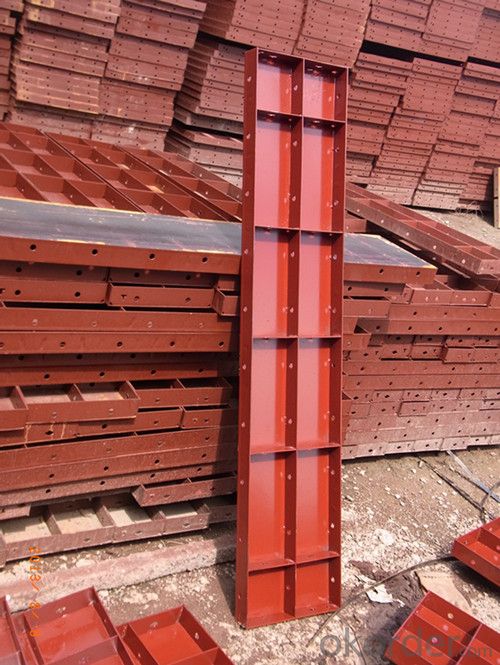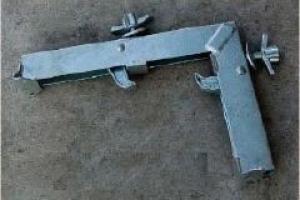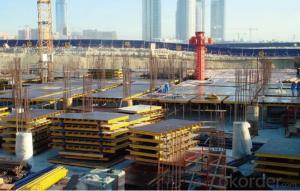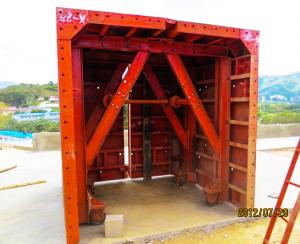Steel Formwork for Skyspare Export to Indonesia
- Loading Port:
- Tianjin
- Payment Terms:
- TT OR LC
- Min Order Qty:
- 100 pc
- Supply Capability:
- 100000 pc/month
OKorder Service Pledge
OKorder Financial Service
You Might Also Like
Introduction for Steel Formwork :
Steel Formwork:used in highway,railway,bridge,tunnel and shearing wall,etc.Our company CNBM which is one of the largest State-Owned Enterprises in China which established in 1984 , has gained the confirmation from the specialist of China Architecture Scence Institute, and has been used by many building operation units and has been highly praised.In 2014, the total turnover volume of CNBM exceeds US$410 billion dollars with a total staff of 180,000. CNBM is listed in the World Top 500 Enterprises !
Characteristic for Wholly Steel Formwork :
1. High Smooth Surface
2. Convex ling for Edge Rib
3. Specialized Connection Pin for Edge Rib Connection
4. High Stiffness for Steel Surface
5. Light Weight for saving producing cost
6. Fast Separate and Easy transport
7. Recycling using
8. Scientific and Reasonable design to meet different working condition
Parameter and Specification :
Code | Size (mm) | Weight (KG) | Code | Size (mm) | Weight (KG) |
P12021 | 1200*2100*55 | 102.96 | P4018 | 400*1800*55 | 28.3 |
P12018 | 1200*1800*55 | 88.4 | P4015 | 400*1500*55 | 23.8 |
P12015 | 1200*1500*55 | 74.15 | P4012 | 400*1200*55 | 19.1 |
P12012 | 1200*1200*55 | 60.11 | P4009 | 400*900*55 | 14.6 |
P10018 | 1000*1800*55 | 76.01 | P4007 | 400*750*55 | 12.3 |
P10015 | 1000*1500*55 | 63.96 | P4006 | 400*600*55 | 9.95 |
P10012 | 1000*1200*55 | 60.11 | P3018 | 300*1800*55 | 20.7 |
P10009 | 1000*900*55 | 39.32 | P3015 | 300*1500*55 | 17.4 |
P9018 | 900*1800*55 | 70.89 | P3012 | 300*1200*55 | 14 |
P9015 | 900*1500*55 | 59.47 | P3009 | 300*900*55 | 10.7 |
P9012 | 900*1200*55 | 48.03 | P3007 | 300*750*55 | 8.8 |
P7518 | 750*1800*55 | 57.8 | P3006 | 300*600*55 | 7.3 |
P7515 | 750*1500*55 | 48.47 | P3004 | 300*400*55 | 5.46 |
P7512 | 750*1200*55 | 39.16 | P2515 | 250*1500*55 | 15.17 |
P7509 | 750*900*55 | 29.85 | P2512 | 250*1200*55 | 12.24 |
P7507 | 750*750*55 | 24.81 | P2509 | 250*900*55 | 9.32 |
P6018 | 600*1800*55 | 43.1 | P2507 | 250*750*55 | 7.71 |
P6015 | 600*1500*55 | 36.3 | P2506 | 250*600*55 | 6.39 |
P6012 | 600*1200*55 | 31.7 | P2015 | 200*1500*55 | 11.6 |
P6009 | 600*900*55 | 23.9 | P2012 | 200*1200*55 | 9.4 |
P6007 | 600*750*55 | 18.55 | P2009 | 200*900*55 | 7.1 |
P6006 | 600*600*55 | 16.25 | P2007 | 200*750*55 | 5.9 |
P5018 | 500*1800*55 | 36.27 | P2006 | 200*600*55 | 6.39 |
P5015 | 500*1500*55 | 30.15 | P2004 | 200*450*55 | 3.64 |
P5012 | 500*1200*55 | 25.55 | P1515 | 150*1500*55 | 9.5 |
P5009 | 500*900*55 | 20.38 | P1506 | 150*600*55 | 4 |
P5007 | 500*750*55 | 15.48 | P1504 | 150*450*55 | 2.98 |
P5006 | 500*600*55 | 13.58 | P1015 | 100*1500*55 | 7.5 |
Code | Size (mm) | Weight (KG) |
P1012 | 100*1200*55 | 6.9 |
P1009 | 100*900*55 | 4.6 |
P1007 | 100*750*55 | 3.8 |
P1006 | 100*600*55 | 3.1 |
P1004 | 100*450*55 | 2.33 |
E1515 | 150*150*1500 | 15.2 |
E1512 | 150*150*1200 | 12.26 |
E1509 | 150*150*900 | 9.34 |
E1507 | 150*150*750 | 7.77 |
E1506 | 150*150*600 | 6.46 |
E1504 | 150*150*450 | 4.87 |
E1015 | 100*150*1500 | 13.13 |
E1012 | 100*150*1200 | 10.61 |
E1009 | 100*150*900 | 8.07 |
E1006 | 100*150*600 | 5.44 |
Y1018 | 100*150*1800 | 14.56 |
Y1015 | 100*150*1500 | 12.29 |
Y1012 | 100*150*1200 | 9.72 |
Y1009 | 100*150*900 | 7.46 |
Y1007 | 100*150*700 | 6.19 |
Y1006 | 100*150*600 | 5.19 |
Y1004 | 100*150*450 | 3.92 |
J0018 | 50*50*1800 | 4.34 |
J0015 | 50*50*1500 | 3.7 |
J0012 | 50*50*1200 | 2.94 |
J0009 | 50*50*900 | 2.3 |
J0007 | 50*50*750 | 1.9 |
J0006 | 50*50*600 | 1.5 |
J0004 | 50*50*450 | 1.13 |
FAQ :
1. Who are we ?
We , CNBM , are a State-Owned Enterprise which established in 1984 , have 32 years experience ,enjoy high reputation .
2. Our Advantage :
Customized products , we have our own R&D department , we can design the drawing and suggest the suitable solution for your project .
3. Our after-Sales Service :
The international Sales Manager and Engineer can go to your job site for work direction and help you deal with your project .
Factory Photos :
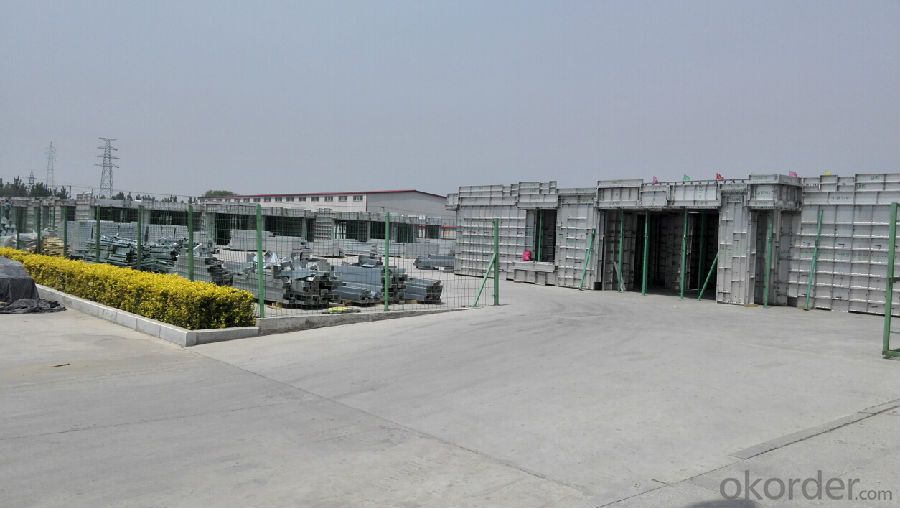
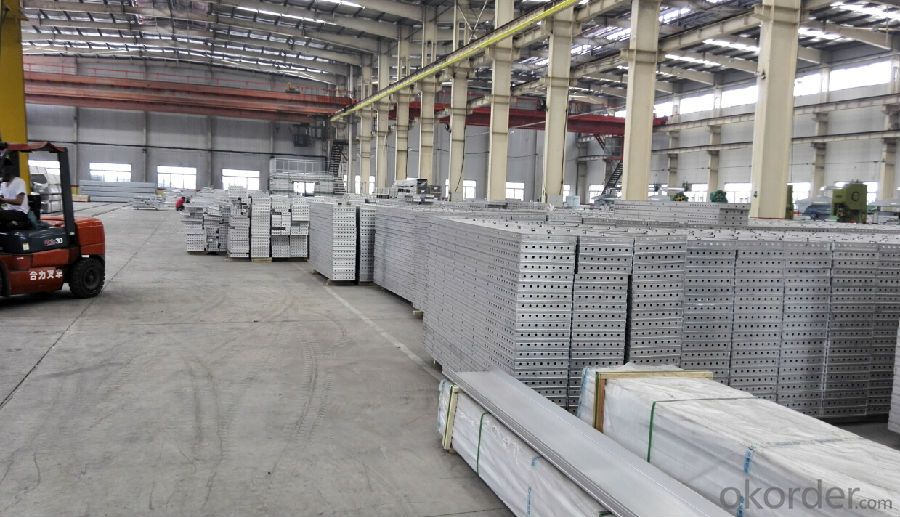
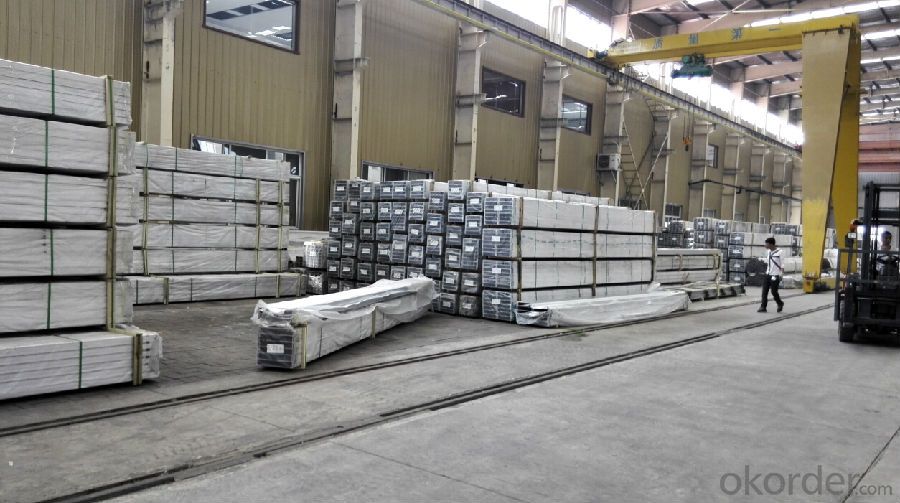
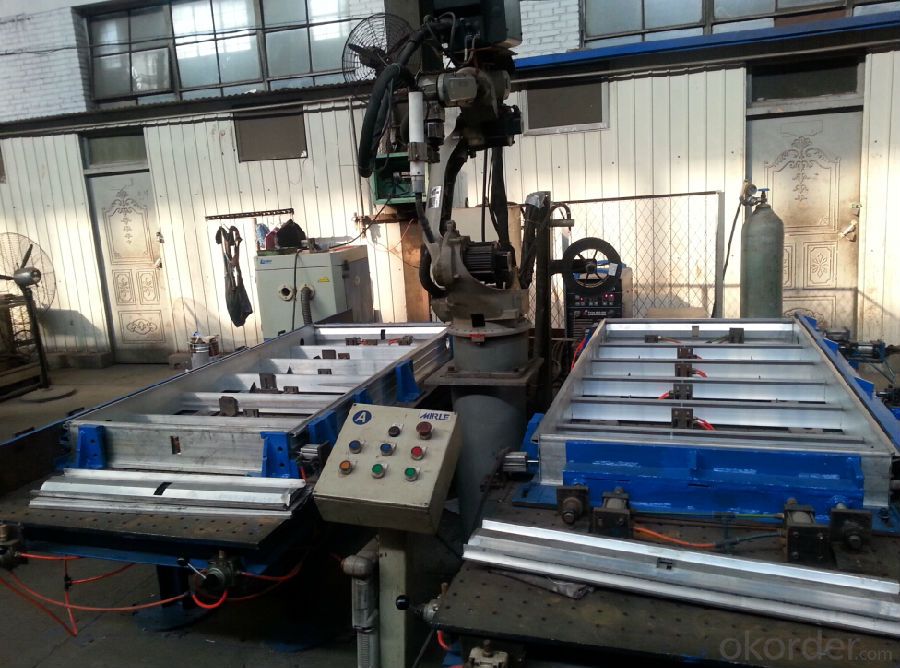
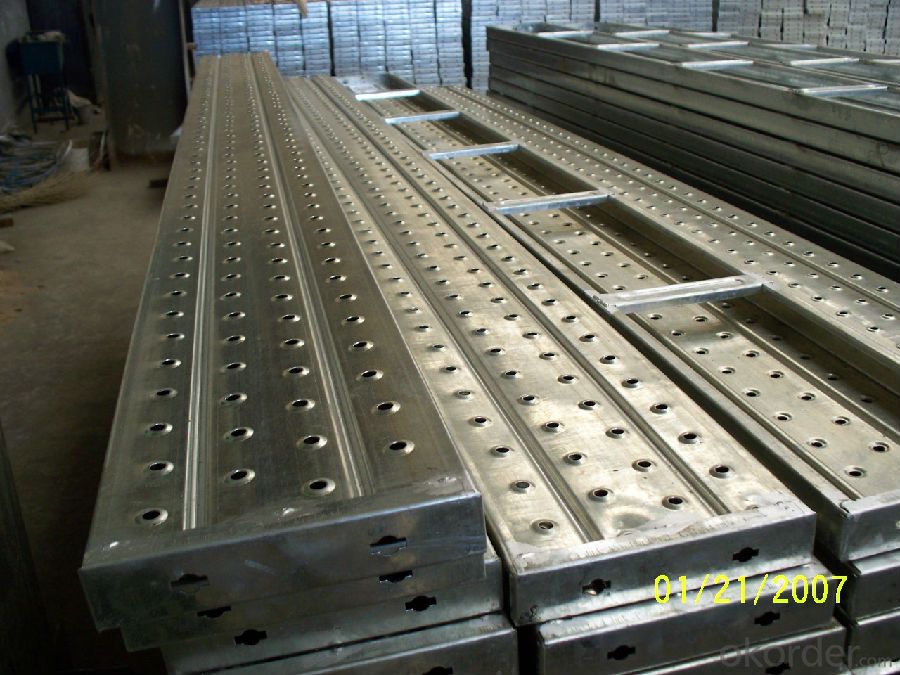
- Q: Are there any regulations or standards that govern the use of steel formwork?
- Yes, there are regulations and standards that govern the use of steel formwork in construction projects. These regulations and standards are put in place to ensure the safety, quality, and durability of steel formwork systems. One of the most widely recognized standards is the American National Standards Institute (ANSI) A10.9-2013 standard for safety requirements in concrete and masonry construction. This standard provides guidelines for the use of formwork, including steel formwork, and covers aspects such as design, construction, inspection, and maintenance. In addition to ANSI, other organizations like the Occupational Safety and Health Administration (OSHA) in the United States and the Health and Safety Executive (HSE) in the United Kingdom also provide regulations and guidelines for the safe use of steel formwork. These regulations cover aspects such as worker safety, proper assembly and dismantling procedures, and the use of appropriate protective equipment. Moreover, there are international standards such as the ISO 9001:2015 for quality management systems, which can also be applied to steel formwork manufacturing and installation processes. These standards ensure that the steel formwork meets certain quality and performance criteria. It is important for construction companies and contractors to adhere to these regulations and standards when using steel formwork to ensure the safety of workers and the overall success of the project. Failure to comply with these regulations can result in penalties, legal issues, and even accidents on-site. Therefore, it is crucial to stay updated with the latest regulations and standards related to steel formwork and implement them accordingly.
- Q: Can steel formwork be used for curved or non-standard concrete shapes?
- Yes, steel formwork can be used for curved or non-standard concrete shapes. Steel formwork is flexible and can be easily customized to create various shapes and designs. It provides strength and stability to the concrete structure, making it suitable for complex and unique shapes. Additionally, steel formwork allows for efficient construction processes and can be reused multiple times, making it a cost-effective option for curved or non-standard concrete shapes.
- Q: How does steel formwork contribute to the overall efficiency of construction processes?
- Steel formwork contributes to the overall efficiency of construction processes by providing a durable and reusable solution for creating temporary molds that shape concrete structures. Its strength and stability allow for faster assembly, easy customization, and precise alignment, reducing construction time and labor costs. Additionally, steel formwork's ability to withstand high pressures and heavy loads ensures the quality and safety of the concrete structures being built.
- Q: What are the common quality control measures for steel formwork?
- Common quality control measures for steel formwork include: 1. Visual Inspection: This involves a thorough examination of the steel formwork to check for any visible defects or damage. Any signs of cracks, dents, or deformations should be identified and addressed. 2. Dimensional Accuracy: The dimensions of the steel formwork, such as the length, width, and height, should be measured and compared to the specified requirements. Any deviations from the required dimensions should be corrected. 3. Material Testing: Steel formwork should undergo material testing to ensure that it meets the required standards and specifications. This may involve testing the tensile strength, yield strength, hardness, and chemical composition of the steel. 4. Welding Inspection: If the steel formwork is welded, the quality of the welds should be inspected. This includes checking for proper penetration, fusion, and the absence of any defects like cracks or porosity. Non-destructive testing methods like ultrasonic or radiographic testing can be employed to ensure the integrity of the welds. 5. Surface Coating Inspection: The surface coating of the steel formwork, such as paint or galvanized coating, should be inspected for its thickness, adhesion, and uniformity. This ensures protection against corrosion and enhances the durability of the formwork. 6. Load Testing: Steel formwork should be subjected to load testing to evaluate its structural integrity and load-bearing capacity. This involves applying a known load to the formwork and monitoring its response to ensure it can safely support the required loads during construction. 7. Documentation and Record Keeping: Quality control measures should be documented and records should be maintained for future reference. This includes recording the inspection results, material test reports, and any corrective actions taken. These quality control measures help to ensure that steel formwork meets the required standards, specifications, and safety regulations, ultimately ensuring the structural integrity and performance of the formwork during construction.
- Q: What are the common safety guidelines when working with steel formwork in confined spaces?
- When working with steel formwork in confined spaces, it is crucial to follow certain safety guidelines to ensure the well-being of the workers involved. Here are some common safety guidelines to consider: 1. Conduct a thorough risk assessment: Before starting any work in a confined space, it is important to assess the potential hazards and risks associated with the task. This assessment should include identifying potential dangers such as inadequate ventilation, limited access, or the presence of hazardous gases. 2. Adequate ventilation: Confined spaces often have limited air circulation, which can lead to a buildup of toxic gases or lack of oxygen. Ensure that the area is properly ventilated before entering and continuously monitor air quality throughout the work. 3. Use appropriate personal protective equipment (PPE): Workers should always wear the necessary PPE, including safety helmets, goggles, gloves, and appropriate respiratory protection. The specific PPE requirements may vary depending on the nature of the confined space and associated hazards. 4. Implement proper lighting: Confined spaces are often poorly lit, making it difficult to see potential hazards and work safely. Adequate lighting should be provided to ensure clear visibility and reduce the risk of accidents. 5. Implement proper entry and exit procedures: Establish clear entry and exit procedures for workers entering and leaving the confined space. This should include proper signage, secure barriers, and a designated person responsible for monitoring and controlling access. 6. Ensure proper communication: Establish a reliable system for communication between workers inside and outside the confined space. This may involve the use of two-way radios, hand signals, or other means of communication to prevent isolation and enable prompt assistance if needed. 7. Regularly inspect equipment and formwork: Prior to starting work, inspect the steel formwork and associated equipment for any damage or defects. Any issues should be promptly addressed to prevent accidents or structural failures. 8. Provide proper training: Workers involved in working with steel formwork in confined spaces should receive appropriate training on safety procedures, hazard recognition, emergency response, and proper use of equipment. Regular training updates should also be conducted to ensure workers remain aware of safety practices. 9. Establish an emergency response plan: Despite taking proper precautions, emergencies can still occur. Establish an emergency response plan that includes procedures for evacuation, rescue, and medical assistance. Ensure that all workers are familiar with the plan and conduct regular drills to practice these procedures. 10. Regularly review and update safety procedures: Safety procedures should be regularly reviewed and updated to incorporate new regulations, industry best practices, or lessons learned from previous incidents. Continuous improvement and monitoring of safety measures are essential to ensure a safe working environment. Remember, working in confined spaces with steel formwork can present significant risks. By following these common safety guidelines and promoting a safety-conscious culture, the risk of accidents and injuries can be minimized, ensuring a safer working environment for all.
- Q: How does steel formwork affect the overall accuracy of concrete structures?
- Steel formwork can greatly improve the overall accuracy of concrete structures. Its rigid and sturdy nature ensures that the concrete is properly shaped and aligned, resulting in precise dimensions and smooth finishes. Steel formwork also helps in minimizing any deformations or imperfections during the curing process, leading to a more accurate and aesthetically pleasing final product. Additionally, the use of steel formwork allows for efficient construction, reducing the risk of errors and ensuring the structural integrity of the concrete structures.
- Q: How does steel formwork affect the overall moisture resistance of the structure?
- Steel formwork does not directly affect the overall moisture resistance of the structure as it is primarily used as a temporary mold for concrete placement. However, if not properly sealed or if there are gaps between the steel formwork and the concrete, it can potentially lead to water infiltration and compromise the moisture resistance of the structure.
- Q: What are the components of a steel formwork system?
- A sturdy and efficient construction formwork is typically created by a steel formwork system, which is composed of several components. These components include: 1. Steel Panels: The primary element of a steel formwork system is high-quality steel panels, available in various sizes and shapes. These panels are designed to withstand the pressure exerted by the concrete during pouring. 2. Steel Walers and Soldiers: To enhance strength and stability, steel walers connect the steel panels horizontally, while soldiers support the steel panels vertically, preventing bulging or deformation under the weight of the concrete. 3. Tie Rods: Threaded rods called tie rods are used to secure the steel panels and walers together. These rods pass through holes in the panels and are secured with nuts and washers. They help maintain the formwork system's structural integrity and resist outward pressure from the wet concrete. 4. Formwork Accessories: To improve efficiency and ease of use, several accessories are used in conjunction with steel formwork systems. These accessories include formwork clamps, pins, cones, and wedges. They ensure alignment and secure the formwork components, preventing any movement during concrete pouring. 5. Formwork Braces: Steel diagonal members known as formwork braces provide additional support and stability to the formwork system. They are installed at regular intervals to prevent sagging or buckling of the formwork. 6. Formwork Joints: Formwork joints connect different sections of the steel formwork system. Depending on the construction project's requirements, these joints can be temporary or permanent. Temporary joints are typically used for modular formwork systems, allowing for easy assembly and disassembly. In summary, a steel formwork system is a durable and robust solution for constructing concrete structures. Its components work together to create a strong and reliable formwork that can withstand the pressures exerted during concrete pouring.
- Q: What are the different types of release agents used with steel formwork?
- There are several different types of release agents that can be used with steel formwork. Some of the most common types include: 1. Water-based release agents: These types of release agents are composed primarily of water, with additives such as surfactants and lubricants. They are environmentally friendly and easy to apply, typically by spraying or brushing onto the steel formwork. Water-based release agents form a thin film on the surface of the steel, preventing adhesion of the concrete during the curing process. 2. Solvent-based release agents: Solvent-based release agents use organic solvents as the carrier for the active ingredients. They are effective in providing a smooth surface finish on the concrete and are often used in situations where a higher level of release performance is required. Solvent-based release agents are typically applied by spraying or brushing and evaporate quickly, leaving a thin film on the steel formwork. 3. Barrier release agents: Barrier release agents are typically applied as a thick paste or gel and provide a physical barrier between the steel formwork and the concrete. They are often used in situations where a high-quality surface finish is required, such as architectural concrete applications. Barrier release agents can be applied by brushing or troweling onto the steel formwork. 4. Dry release agents: Dry release agents are powdered or granular materials that are applied directly to the steel formwork. They create a non-stick surface by absorbing excess moisture from the concrete, preventing adhesion. Dry release agents are commonly used in situations where other types of release agents may not be suitable, such as in cold weather conditions. 5. Form release oils: Form release oils are petroleum-based products that are commonly used with steel formwork. They provide an effective release barrier between the steel and the concrete, preventing adhesion. Form release oils are typically applied by spraying or brushing onto the steel formwork and can be used in a variety of concrete applications. It is important to select the appropriate type of release agent based on the specific requirements of the project, including the desired surface finish, environmental considerations, and ease of application. Consulting with a professional or manufacturer's recommendations can help determine the most suitable release agent for a particular steel formwork application.
- Q: How does steel formwork affect the overall acoustic properties of the structure?
- Steel formwork does not have a significant impact on the overall acoustic properties of a structure. However, it may slightly reduce sound transmission due to its dense and rigid nature compared to other formwork materials such as wood or plastic.
Send your message to us
Steel Formwork for Skyspare Export to Indonesia
- Loading Port:
- Tianjin
- Payment Terms:
- TT OR LC
- Min Order Qty:
- 100 pc
- Supply Capability:
- 100000 pc/month
OKorder Service Pledge
OKorder Financial Service
Similar products
Hot products
Hot Searches
Related keywords
